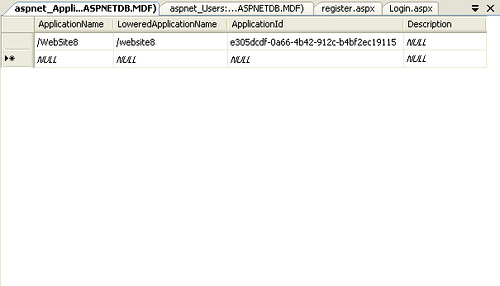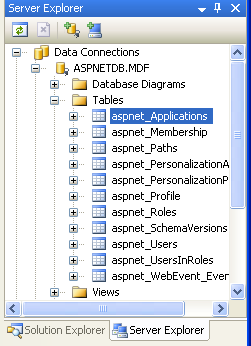select.aspx
---------------------------------------------
<%@ Page Language="C#" %>
<%@ import Namespace="System.Data" %>
<%@ import Namespace="System.Data.SqlClient" %>
<script runat="server">
protected void Page_Load(Object sender, EventArgs e)
{
int intPageNo,intPageSize,intPageCount;
intPageSize = 25;
if (Request["CurrentPage"]==null)
{
intPageNo = 1;
}
else
{
intPageNo = Int32.Parse(Request["CurrentPage"]);
}
SqlConnection mySqlConnection = new SqlConnection("server=(local);Database=test;user id=sa;password=");
SqlCommand mySqlCommand = new SqlCommand("up_GetTopicList", mySqlConnection);
mySqlCommand.CommandType = CommandType.StoredProcedure;
SqlParameter workParm;
//搜索表字段,以","号分隔
workParm = mySqlCommand.Parameters.Add("@a_TableList", SqlDbType.VarChar, 200);
mySqlCommand.Parameters["@a_TableList"].Value = "OFFERID,type,offertime";
//搜索表名
workParm = mySqlCommand.Parameters.Add("@a_TableName", SqlDbType.VarChar, 30);
mySqlCommand.Parameters["@a_TableName"].Value = "offer";
//搜索条件,如"select * from aa where a=1 and b=2 and c=3"则条件为"where a=1 and b=2 and c=3"
workParm = mySqlCommand.Parameters.Add("@a_SelectWhere", SqlDbType.VarChar, 500);
mySqlCommand.Parameters["@a_SelectWhere"].Value = "where type=’idl’";
//表主键字段名,必须为INT
类型
workParm = mySqlCommand.Parameters.Add("@a_SelectOrderId", SqlDbType.VarChar, 50);
mySqlCommand.Parameters["@a_SelectOrderId"].Value = "offerid";
//排序,可以使用多字段排序但主键字段必需在最前面
workParm = mySqlCommand.Parameters.Add("@a_SelectOrder", SqlDbType.VarChar, 50);
mySqlCommand.Parameters["@a_SelectOrder"].Value = "order by offerid desc";
//页号
workParm = mySqlCommand.Parameters.Add("@a_intPageNo", SqlDbType.Int);
mySqlCommand.Parameters["@a_intPageNo"].Value = intPageNo;
//每页显示数
workParm = mySqlCommand.Parameters.Add("@a_intPageSize", SqlDbType.Int);
mySqlCommand.Parameters["@a_intPageSize"].Value = intPageSize;
//总记录数(存储过程输出参数)
workParm = mySqlCommand.Parameters.Add("@RecordCount", SqlDbType.Int);
workParm.Direction = ParameterDirection.Output;
//当前页记录数(存储过程返回值)
workParm = mySqlCommand.Parameters.Add("RowCount", SqlDbType.Int);
workParm.Direction = ParameterDirection.ReturnValue;
mySqlConnection.Open();
Repeater.DataSource = mySqlCommand.ExecuteReader();
Repeater.DataBind();
mySqlConnection.Close();
Int32 RecordCount = (Int32)mySqlCommand.Parameters["@RecordCount"].Value;
Int32 RowCount = (Int32)mySqlCommand.Parameters["RowCount"].Value;
LabelRecord.Text = RecordCount.ToString();
LabelRow.Text = intPageNo.ToString();
intPageCount = RecordCount/intPageSize;
if ((RecordCount%intPageSize)>0)
intPageCount += 1;
LabelPage.Text = intPageCount.ToString();
if (intPageNo>1)
{
HLFistPage.NavigateUrl = "select.aspx?CurrentPage=1";
HLPrevPage.NavigateUrl = String.Concat("select.aspx?CurrentPage=","",intPageNo-1);
}
else
{
HLFistPage.NavigateUrl = "";
HLPrevPage.NavigateUrl = "";
//HLFistPage.Enabled = false;
//HLPrevPage.Enabled = false;
}
if (intPageNo<intPageCount)
{
HLNextPage.NavigateUrl = String.Concat("select.aspx?CurrentPage=","",intPageNo+1);
HLEndPage.NavigateUrl = String.Concat("select.aspx?CurrentPage=","",intPageCount);
}
else
{
HLNextPage.NavigateUrl = "";
HLEndPage.NavigateUrl = "";
//HLNextPage.Enabled=false;
//HLEndPage.Enabled=false;
}
}
</script>
<html>
<meta http-equiv="Content-Type" content="text/html; charset=gb2312">
<head>
<link href="/style.css" rel="stylesheet" />
<style type="text/css">
.high { font-family: "宋体"; font-size: 9pt; line-height: 140%}
.mid { font-size: 9pt; line-height: 12pt}
.small { font-size: 9pt; line-height: normal}
.TP10_5 {
font-size: 14px;
line-height: 140%;
}
</style>
<style type="text/css">A:link {
COLOR: #cc6666
}
</style>
</head>
<body>
<form runat="server">
<span
class="high"> 第<font color="#CC0000"><asp:Label id="LabelRow" runat="server"/></font>页 | 共有<asp:Label id="LabelPage" runat="server"/>页
| <asp:Label id="LabelRecord" runat="server"/>条信息 |
<asp:HyperLink id="HLFistPage" Text="首页" runat="server"/>
| <asp:HyperLink id="HLPrevPage" Text="上一页" runat="server"/>
| <asp:HyperLink id="HLNextPage" Text="下一页" runat="server"/>
| <asp:HyperLink id="HLEndPage" Text="尾页" runat="server"/></span><br>
<asp:Repeater id=Repeater runat="server">
<HeaderTemplate>
<table width="583" border="0" cellspacing="0" cellpadding="0">
<tr>
<td bgcolor="#000000"><table width="100%" border="0" cellpadding="4" cellspacing="1"
class="TP10_5">
<tr bgcolor="#999999">
<td align="center"> <strong><font color="#FFFFFF">订单号</font></strong></td>
<td align="center"> <strong><font color="#FFFFFF">服务项目</font></strong></td>
<td align="center"> <strong><font color="#FFFFFF">预订日期</font></strong></td>
<td align="center"> <strong><font color="#FFFFFF">操作人员</font></strong></td>
<td align="center"> <strong><font color="#FFFFFF">分配状态</font></strong></td>
<td> <div align="center"></div></td>
</tr>
</HeaderTemplate>
<ItemTemplate>
<tr align="center" bgcolor="#FFFFFF"
class="small" onMouseOver=’this.style.background="#CCCCCC"’ onMouseOut=’this.style.background="#FFFFFF"’>
<td><%# DataBinder.Eval(Container.DataItem, "offerid") %></td>
<td><%# DataBinder.Eval(Container.DataItem, "type") %></td>
<td><%# DataBinder.Eval(Container.DataItem, "offertime") %></td>
<td> </td>
<td> </td>
<td><a href="
javascript:void(window.open(’info.asp?id=<%# DataBinder.Eval(Container.DataItem, "offerid") %>’,’订单分配’,’height=600,width=1000’))">订单详情</a></td>
</tr>
</ItemTemplate>
<FooterTemplate>
</table></td>
</tr>
</table>
</FooterTemplate>
</asp:Repeater>
</form>
</body>
</html>
------------------------------------------------
up_GetTopicList.sql
------------------------------------------------
CREATE proc up_GetTopicList
@a_TableList Varchar(200),
@a_TableName Varchar(30),
@a_SelectWhere Varchar(500),
@a_SelectOrderId Varchar(20),
@a_SelectOrder Varchar(50),
@a_intPageNo int,
@a_intPageSize int,
@RecordCount int OUTPUT
as
/*定义局部变量*/
declare @intBeginID int
declare @intEndID int
declare @intRootRecordCount int
declare @intRowCount int
declare @TmpSelect NVarchar(600)
/*关闭计数*/
set nocount on
/*求总共根贴数*/
select @TmpSelect = ’set nocount on;select @SPintRootRecordCount = count(*) from ’+@a_TableName+’ ’+@a_SelectWhere
execute sp_executesql
@TmpSelect,
N’@SPintRootRecordCount int OUTPUT’,
@SPintRootRecordCount=@intRootRecordCount OUTPUT
select @RecordCount = @intRootRecordCount
if (@intRootRecordCount = 0) --如果没有贴子,则返回零
return 0
/*判断页数是否正确*/
if (@a_intPageNo - 1) * @a_intPageSize > @intRootRecordCount
return (-1)
/*求开始rootID*/
set @intRowCount = (@a_intPageNo - 1) * @a_intPageSize + 1
/*限制条数*/
select @TmpSelect = ’set nocount on;set rowcount @SPintRowCount;select @SPintBeginID = ’+@a_SelectOrderId+’ from ’+@a_TableName+’ ’+@a_SelectWhere+’ ’+@a_SelectOrder
execute sp_executesql
@TmpSelect,
N’@SPintRowCount int,@SPintBeginID int OUTPUT’,
@SPintRowCount=@intRowCount,@SPintBeginID=@intBeginID OUTPUT
/*结束rootID*/
set @intRowCount = @a_intPageNo * @a_intPageSize
/*限制条数*/
select @TmpSelect = ’set nocount on;set rowcount @SPintRowCount;select @SPintEndID = ’+@a_SelectOrderId+’ from ’+@a_TableName+’ ’+@a_SelectWhere+’ ’+@a_SelectOrder
execute sp_executesql
@TmpSelect,
N’@SPintRowCount int,@SPintEndID int OUTPUT’,
@SPintRowCount=@intRowCount,@SPintEndID=@intEndID OUTPUT
if @a_SelectWhere=’’ or @a_SelectWhere IS NULL
select @TmpSelect = ’set nocount off;set rowcount 0;select ’+@a_TableList+’ from ’+@a_TableName+’ where ’+@a_SelectOrderId+’ between ’
else
select @TmpSelect = ’set nocount off;set rowcount 0;select ’+@a_TableList+’ from ’+@a_TableName+’ ’+@a_SelectWhere+’ and ’+@a_SelectOrderId+’ between ’
if @intEndID > @intBeginID
select @TmpSelect = @TmpSelect+’@SPintBeginID and @SPintEndID’+’ ’+@a_SelectOrder
else
select @TmpSelect = @TmpSelect+’@SPintEndID and @SPintBeginID’+’ ’+@a_SelectOrder
execute sp_executesql
@TmpSelect,
N’@SPintEndID int,@SPintBeginID int’,
@SPintEndID=@intEndID,@SPintBeginID=@intBeginID
return(@@rowcount)
--select @@rowcount
GO







 本文介绍ASP.NET WebForm中父窗体与子窗体间参数传递的方法,包括使用JavaScript进行子窗体关闭及参数回传的技术细节。
本文介绍ASP.NET WebForm中父窗体与子窗体间参数传递的方法,包括使用JavaScript进行子窗体关闭及参数回传的技术细节。






















 2782
2782

 被折叠的 条评论
为什么被折叠?
被折叠的 条评论
为什么被折叠?








